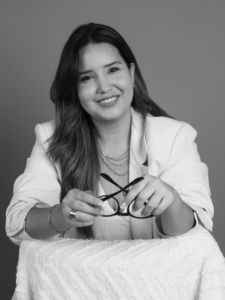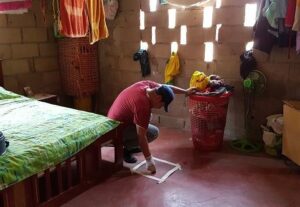An hour before the official launch of her first book, Colombian journalist Eél María Angulo wasn’t rehearsing her speech or making last-minute preparations. Instead she was changing the passwords to her social media accounts and emails due to repeated hacking attempts.
On October 17, 2024, Angulo presented her book Un veneno llamado plomo – in English: A Poison Called Lead – to an audience in Bogotá. It was the culmination of ten years of investigation into the consequences of metal smelting in Colombia. Her work earned her the Simón Bolívar National Journalism Award in 2015 and the Ibero-American King of Spain Award for Environmental Journalism in 2017. However, it also made her a target of attacks by people connected to Colombia’s lead industry.

Eél María Angulo is currently a reporter for the international news network France 24 in Spanish. (Photo: Courtesy)
Still, Angulo’s persistence has been fueled by her desire to give a platform to the voices of children from poor, remote regions of Colombia who have suffered and died from lead poisoning after smelting plants were established in their communities without proper regulations.
“This is for the memory of those children,” Angulo told LatAm Journalism Review (LJR). “It’s our children, nephews, and neighbors who are most vulnerable with a smelter plant set up nearby. If regulations aren’t tightened, this will keep happening.
LJR spoke with Angulo, currently a reporter for the international news network France 24 in Spanish, about the creation of her book, the importance of investigative journalism, and the risks faced particularly by journalists in small cities and rural areas.
The interview has been edited for brevity and clarity.
Eél María Angulo: The main reason I’ve persisted with this investigation is the children.
I started the investigation in 2014 after hearing about three children with lead poisoning. A woman called a popular radio show in Barranquilla to report that three children from the same family were hospitalized in the northern part of the city, and it struck me as odd. I wondered who was paying for their care and why they were there. But what stood out even more was the host’s lack of concern for the public health issue the caller was raising.
That day, I went to the newsroom and told my editor—I had been working as a reporter for about a year and a half at El Heraldo and had just been promoted to local features writer—that this was an important story.
When we began investigating, we discovered it wasn’t about only those three children. At least 300 children in the region had cognitive difficulties and lived near lead smelters. They were sick, and their mothers all reported being exposed to the smelters’ fumes.
Children are more sensitive to lead accumulation in their blood. It settles in their teeth and bones. Neurological damage appears much faster in children than in adults because their prefrontal cortex is not fully developed. The effects are also more permanent in children, yet they are rarely tested for lead poisoning due to the invasive nature of the tests.
I also witnessed how smelter operators bribed officials to alter death certificates for the children and exploited the affected population’s socioeconomic conditions.
Many times, I asked myself: why? Why am I so focused on this? And the answer was always the children. It’s not fair that in a world run by adults, the ones suffering the most from this issue don’t have a voice to speak for them.

Sampling for evaluation of lead contamination in soil in the El Carmen village. (Photo: Pure Earth and Mayor's Office of Malambo)
When we won the King of Spain Award in 2017, journalist Juan Cruz interviewed me for El País with the headline: “If you mess with lead, we’ll give you lead.” That was the most direct threat I received.
I now realize the risk I took. I was just 22 years old when someone called me at the newsroom, said that, and hung up. That’s when I understood the need for security protocols in newsrooms, which we often lack.
I changed my phone several times. When we visited smelting plants, guards would show us weapons, threaten my family, and I eventually had to leave Barranquilla.
After the documentary aired on RCN, I didn’t return to Barranquilla on the advice of colleagues at El Heraldo. They told me, “Don’t come back here.”
For me, as the daughter of parents who raised me lovingly, it was devastating. It was a significant moment in my career, but I couldn’t share it with my family for safety reasons. I’ve even asked my family to deny knowing me and not to say I’m their daughter or sister.
I have no regrets, but before publishing the book, there were nights I thought, “They might kill me for this.”
The idea for the book began after winning the King of Spain Award at a café in Madrid called Gijón. I was there, and journalist Juan Cruz introduced me to his literary agent, who made the first book offer. At the time, they asked me to write a novel.
I started, but I wasn’t satisfied because I couldn’t prove it was real. This wasn’t fantasy or magical realism. Reality was greater than fiction in this case. So, I paused the project.
In February 2022, as a resident in the Netherlands, I resumed the investigation, expanding it to Europe. I visited contaminated sites in Rome and Rotterdam, spoke with scientists, and discovered how lead affects the world. I even found out that Rembrandt and Van Gogh suffered from lead poisoning due to the paints they used. I thought, “No, I don’t want to write a novel right now.”
In December 2023, I received an offer from the publishing house of El Tiempo, Colombia’s biggest newspaper, to write this book. From January until now, I stopped all activities to dedicate myself to this project wholeheartedly. Writing a book is like crafting jewelry—word by word, reading and rereading until your eyes bleed. You get to a point where you know the book by heart.
The book launched in October, but we’ll be at the Bogotá Book Fair in April, and they’re organizing a launch at the main bookstore in Barranquilla. That will be a challenge, as it’s where the story began.
In the rest of the country, the main risk is lack of protection. We are entirely unprotected because the entities and systems that safeguard journalists are centralized in Bogotá. For example, organizations like the Foundation for Press Freedom and others that could offer support have much longer and more drawn-out processes in small cities and rural areas.
Second, local news outlets have fewer financial resources. You do journalism with your bare hands.
Third, the fight for power is more intense and visible than in the capital. It’s no secret that regions are dominated by political clans that control public institutions, licenses, and budgets. Investigating them poses a safety risk to journalists, their families, colleagues, and sources.

"Un veneno llamado plomo" is the culmination of ten years of investigation into the consequences of metal smelting in Colombia. (Photo: Courtesy)
In smaller communities, you’re more vulnerable. As they say, “small town, big hell.” Everyone knows where you live and your routines. Your life is worth $20USD because some people are willing to kill you for that much.
Doing investigative journalism outside the capital often feels lonely. If something happens, they kill you, and the media and colleagues move on. The person who’s going to cry for you is your mother, but after two days people are going to forget. Investigative journalism outside the capital requires more courage and bravery.
Being an investigative journalist, especially on environmental and social issues, means being an activist. It means taking a personal stand on a cause that could cost you your life, even when people don’t care—because, let’s face it, people are focused on their own well-being. Collective well-being stopped being newsworthy or of interest to the media long ago.
So in a field driven by money, for a journalist to say, “I know this, and I’ll tell it no matter what,” needs public support now more than ever.
Social media’s triviality has also contributed to this. One moment, people pay attention, and two minutes later, no one cares. Why? Because it doesn’t directly affect them. That’s where persistence comes in. The greatest tool of an investigative journalist is persistence. Investigative journalism isn’t done in two days. It’s a long-term endeavor that becomes a life’s purpose. When you choose a topic to investigate, it can stay with you for the rest of your life.